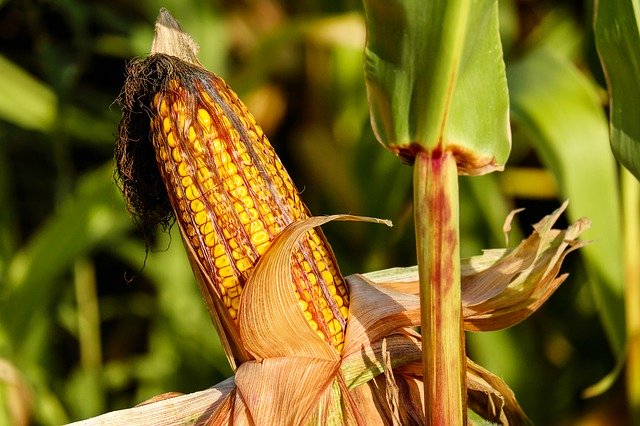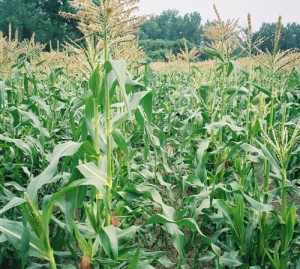Corn

 Tips And Hints For Growing Easy-Care Warm-Season Crops
Tips And Hints For Growing Easy-Care Warm-Season Crops
Planting months: March through July Spacing: thin plants 8 top 12 iches apart, rows three feet apart.. Special Tips: Grow in block, rather than long, skinny row, plant north of other vegies. Protect seeds with inverted berry basket. Presprout shrivelled type seeds. Isolate super-sweet varieties to prevent cross-polination (see page 137 of my book for explanation of open-pollinated, Su or standard varieties, SH2 or Supersweet Hybrids, and SE or Shugary Enhanced Hybrids.) Don’t take off the suckers (side shoots)!
Water and feed extra when silks appear. In small gardens, hand pollinate for best crop. Harvesting:70 to 90 days. When tips of silks go crispy brown and ears fill out, pierce kernal with thumb nail, clear juice means notready, milky juice means just right, dry and pasty means overripe, Recommended Varieties: How Sweet It Is and Early X-tra Sweet (Sh2 Supersweet), Honey n Pearl (Sh2 Supersweet bicolor),Sugary Enhanced: Miracle, Sugar Snow (white), and Honey n Cream. For dry soils and strong disease resistance, try Tuxedo or the bi-color Lancelot.
NOTE: If you are growing vegetables year-round there will be some carry over of cool-season crops into warm weather, for example artichokes, which can be put in from transplants in March and harvested in June, or globe onions, which are planted from seeds in November and harvested in late May or June, and strawberries which are also planted in November and harvested throughout spring into early summer.


Might this work. collect corn pollen in a can, small amount of water,dip corn silk in the water for max pollenation just an idea I plan for 3 or 4 stocks to see if I can get a full ear of corn Don Ford
Gardeners can easily hand-pollinate corn and it’s always wise to do this when you only are growing a few stalks. But the method you describe is not the right way. (I will describe the process I have devised in the next paragraph. It works like a dream.) Don’t try to put the pollen into a can. It would escape, and for goodness sakes don’t put water onto the corn silks. That would be like dew. Heavy dew prevents pollination. It does not enhance it. The silks are sticky already. Nature makes them that way so that ideally each one can capture one tiny grain of pollen. All it takes to fertilize that kernel and make it grow is for one grain of pollen to land on that silk. It is a random process and works very well in a field of corn when a light wind is shakes the tassels and releases the pollen like a cloud filling the air, which then settles and after this happens several times over several days reaches every single thread of every silk in the whole field. But of course in a home garden with very few stalks, the pollen can blow away on the wind and never reach the silks it was meant to pollinate. Have you attended any of my talks on summer veggies? I give many many tips and hints for all the major crops. When talking about corn I always demo how to hand pollinate it a home garden. First wait until the pollen is ripe and the silks have emerged and they are fresh and yellow. Then go out in the garden in the morning after the dew has dried off. (The pollen needs to be dry and the silks as well. The silks are naturally sticky.) Then go down the row. Break off an individual piece of the pollen-covered tassel here and there and hit it onto the silks. Leave some of the pollen-bearing tassels on the stalks so you can do the job again if necessary. By doing this only once or sometimes twice each season I have many times grown ears of corn that are filled out to the very last kernel—not one single kernel is missing but filled out all the way to the tip! By doing this several times as the ears grow, but often only once, I have a achieved perfect ears every time. Check my schedule of events and see if you can attend one of my talks about growing summer veggies or on growing veggies year round. My lecture series is coming up soon (March 2014.) I also have a wonderful lecture filled with tips and hints on growing winter crops but of course I give that talk in autumn. My veggie talks are PowerPoint and have spectacular slides to go with them.
I have a small 10 acer farm in California in Zone 9 with large garden and an assortment of animals. This summer we grew a nice size patch of sweet corn and indian corn with beans and assortment of pumkins at far end. All the corn has been harvested and the stalks are left in place for the birds at the moment, and we feed some to pigs and sheep. I wanted to try and cut the stalks to 10-12 inches tall and plant brocalli and other brassica right at the base of corn without tilling (we get NO snow here). I thought this would help with the deer walking in (we do have a deer fence but building some barn stuff so not secure at moment.) All the corn is organic hertiage varities and we dont spray ever. Do you think this will be successful?
The problem with corn stalks is that they get hard as a rock. On our family farm where I lived in Pennsylvania during the Second World War, we cut off the stalks of field corn with a machete when they were still soft and then arranged the stalks into a teepee-like shape and tied them up. The stalks were chopped up to put into the silo and make silage for the cows. The corn was husked and used for food during winter for pigs and other animals. We plowed the field under in late winter or early spring.
During the time that the cut stalks were standing it was dangerous to run in that field. If one tripped and fell one could have been killed.
I really don’t think that the corn stalks will help to keep out the deer. They can carefully walk around them.Best thing is to build a big wire cage in which to grow vegetables.